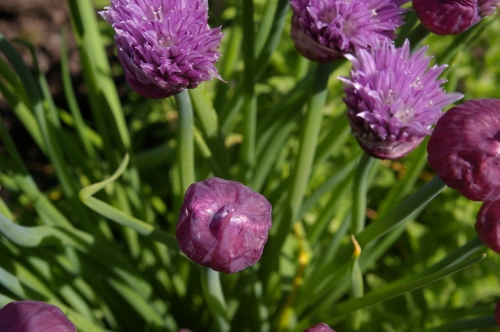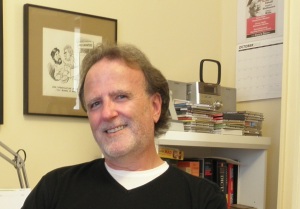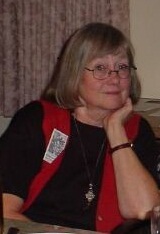This was going to be another post about poems that I’ve sold and in a way it is. But it is  more than that. Last year on March 20th my brother Dennis died unexpectedly, though he had been in ill health for a few years and we had been justifiably worried. Spring when everything is bloom is now inextricably linked with death for me.
more than that. Last year on March 20th my brother Dennis died unexpectedly, though he had been in ill health for a few years and we had been justifiably worried. Spring when everything is bloom is now inextricably linked with death for me.
Dennis was the eldest of four and he was burdened not so much by being the big brother but by the world. He always wanted to make the world a better place, and that probably started with being the support for his siblings, in believing in us and helping hold us together. We four were weighted by the way our narcissistic parents had used us, who had planted seeds of doubt, self-loathing, fear and sadness deep within us. We battled or succumbed in different ways. Our parents’ needs drew the four of us together. We certainly weren’t always united, and we could drive each other crazy but we have always remained close.
That mentally unhealthy upbringing affected everyone. Not only did Dennis feel he had to be there for us, he had to also be there for the world. If he wasn’t giving and contributing to the betterment of society and humankind, he didn’t feel his life was worth living. I worried at different times that he would kill himself if he couldn’t find this deep purpose. He never had a hobby. Perhaps if there was any hobby, it was Dennis’s love of animals, something we all shared. But he could never just let go and ease himself into something mindless, something to let his mind rest for a bit and regenerate.
It is what killed him. He literally could never sleep. His body forgot how to turn off, even with machines and medicines. He could never shut his brain down and stop thinking of ways to make the world better. Dennis never finished high school. In some ways he was too smart for it and I’m sure desperately unhappy, searching for a sense of place. I doubt any of us were happy in high school though I think if you look back there were probably more searching lost teenagers than there were contented ones.
In seeking approval in my mother’s eyes, Dennis strove to do more. He was successful in  provincial politics. He became a Thai Consul, he worked on senate reform, and was Edmonton’s police commissioner. He worked in other parts of the world, trying to assist various cities and countries with government. And he worked at advocating for mental health, something that we had never really had in our family. He was given an honorary doctorate for his work. Dennis contributed a lot to mental health and created the Chimo Project, which brought pet assisted therapy to Alberta long before experts were recognizing the benefits of animal-human interactions and healing.
provincial politics. He became a Thai Consul, he worked on senate reform, and was Edmonton’s police commissioner. He worked in other parts of the world, trying to assist various cities and countries with government. And he worked at advocating for mental health, something that we had never really had in our family. He was given an honorary doctorate for his work. Dennis contributed a lot to mental health and created the Chimo Project, which brought pet assisted therapy to Alberta long before experts were recognizing the benefits of animal-human interactions and healing.
I could go on about my deep-thinking brother, who was perhaps only second to my mother in stubbornness about their own health. He didn’t believe he could be helped, he was leery of psychologists/counsellors/psychiatrists and thought they would bleed his secrets to the world. He resisted seeking treatment. Dennis always tried to see from another person’s point of view, and it was as his body was deteriorating that I saw a darker side come out. I had rarely seen him angry until those later years, where that dark mood and glumness was troublesome and he became more fatalistic. He seemed to believe less in democracy as all the ills of the world ate at him.

This bee, here.
Yet, he still cared about us and we, about him. Last March 20th was the first day of spring. I found a bee on the steps staggering about, having awakened too early to a chilly day. I rescued it and brought it sugar water at about the same time as my brother was dying in another province. I like to think that as the weight of the world and his burdened brain wore down, that his spirit lifted free and ended up in that bee, small and seeking nectar and the warmth of a new day. I like to think that he was finally able to fly away from worry and sadness.
It does not feel like a year. I still cry every week, missing him. And this is about poetry. In trying to move through my grief, to not cry constantly, I immersed myself in poetry. I couldn’t write longer works because of my sorrow, so poetry it was. I started exploring different forms, where structure and length occupied my mind with these word puzzles. In a way, I became obsessed and have written more poems in a year than probably many years combined.
That obsession hasn’t stopped. I’m still exploring forms and writing poems. But my many many poems that have sat for years have had a scrubbing. I’ve not only written new works and explored different themes but I’ve truly looked deeply at my old poems, asking myself, what does that mean? Some of these haven’t sold in over 20 years. In some cases, I set them aside, feeling something wasn’t right—the proof was in no sales. With other poems, I would send them out, not always every year.
Now, with this deep cleansing I have rewritten quite a few poems and have submitted them resurrected and they’re selling. In this way, every time a poem is sold, it reminds me of how my brother believed in me and how, even though he is no longer physically here, he continues to inspire me. I know that if he were to read this, he would kind go “Huhmp!” raise his eyebrows and give me a look.
I think of my brother every time I sell a poem. The ones sold in the past month (the ones with links are already published) and with different release dates are:
- “Monster” in Breath and Shadow
- “Telltale Moon” in Dreams and Nightmares
- “masquerade” in OnSpec
- An untitled hay(na)ku “luring” and my first haibun “Sacrifice” in Scifaikuest
- “Three’s a Charm” in Songs of Eretz Poetry
- “Spinning Wheel,” “Broken Words” and “Penned By My Hand” in Cascadia Subduction Zone
- “Hacker Halloween” in Polar Borealis #14
- “Family Dinner, Prince George” and “Sweat Lodge” in Transition magazine
- “Hand of Fate” in Cosmic Horror Monthly
- “Widow’s Lament” in The Weird and the Whatnot
- “To the Core” in TERSE Journal
To my brother, I thank you. I miss you and I still wish you were here.


 A Summoning of Demons
A Summoning of Demons
 ## published in Call of the God: An Anthology Exploring the Divine Masculine Within Modern Paganism, 2015
## published in Call of the God: An Anthology Exploring the Divine Masculine Within Modern Paganism, 2015 Michelle Jeffrey is a poet, artist, dreamer and cat whisperer who likes to weave mythology, music and poetry into the rhythm of rituals and ceremonies. She is a regular contributor of poetry and articles to pagan magazines in Australia. Her poetry has also appeared in the Spectral Realms: A Weird Poetry Journal and Call of the God: An Anthology Exploring the Divine Masculine Within Modern Paganism. Michelle resides in Sydney, Australia with her husband and two cats.
Michelle Jeffrey is a poet, artist, dreamer and cat whisperer who likes to weave mythology, music and poetry into the rhythm of rituals and ceremonies. She is a regular contributor of poetry and articles to pagan magazines in Australia. Her poetry has also appeared in the Spectral Realms: A Weird Poetry Journal and Call of the God: An Anthology Exploring the Divine Masculine Within Modern Paganism. Michelle resides in Sydney, Australia with her husband and two cats.
 Today’s guest in Sara Tantlinger, another pretty amazing poet.
Today’s guest in Sara Tantlinger, another pretty amazing poet. And then my collection The Devil’s Dreamland, which won the 2018 Bram Stoker Award, was inspired by the life and lies of serial killer H.H. Holmes. The poems dip into his point of view pretty heavily, but I also included poems from the perspective of his victims, the city, and his murder castle in 1800s Chicago.
And then my collection The Devil’s Dreamland, which won the 2018 Bram Stoker Award, was inspired by the life and lies of serial killer H.H. Holmes. The poems dip into his point of view pretty heavily, but I also included poems from the perspective of his victims, the city, and his murder castle in 1800s Chicago. Poetry Inspired by H.H. Holmes. She is a poetry editor for the Oddville Press, a graduate of Seton Hill’s MFA program, a member of the SFPA, and an active member of the HWA. Her other books include Love for Slaughter and To Be Devoured. Her poetry, flash fiction, and short stories can be found in several magazines and anthologies, including The Twisted Book of Shadows, Sunlight Press, Unnerving, and Abyss & Apex. She embraces all things strange and can be found lurking in graveyards or on Twitter @SaraJane524 and at
Poetry Inspired by H.H. Holmes. She is a poetry editor for the Oddville Press, a graduate of Seton Hill’s MFA program, a member of the SFPA, and an active member of the HWA. Her other books include Love for Slaughter and To Be Devoured. Her poetry, flash fiction, and short stories can be found in several magazines and anthologies, including The Twisted Book of Shadows, Sunlight Press, Unnerving, and Abyss & Apex. She embraces all things strange and can be found lurking in graveyards or on Twitter @SaraJane524 and at 
 Whenever I finish a new story, the first thing my reader friends usually ask is, “Are there spiders in this one?” Because, yeah, usually. I have a bit of a spider reputation. I love them and I think our culture has unjustly vilified them. They often feature as protagonists or positive symbols in my work, as they have in much of mythology throughout the world. My recently released novel, The Bone Weaver’s Orchard features a lot of spiders (and other crawlies) as well as a protagonist who loves them. Like Charley Winslow in my book, I keep a menagerie of spiders, though mine roam freely through my house. My basement is full of Cellar Spiders−thousands of them.
Whenever I finish a new story, the first thing my reader friends usually ask is, “Are there spiders in this one?” Because, yeah, usually. I have a bit of a spider reputation. I love them and I think our culture has unjustly vilified them. They often feature as protagonists or positive symbols in my work, as they have in much of mythology throughout the world. My recently released novel, The Bone Weaver’s Orchard features a lot of spiders (and other crawlies) as well as a protagonist who loves them. Like Charley Winslow in my book, I keep a menagerie of spiders, though mine roam freely through my house. My basement is full of Cellar Spiders−thousands of them. There are benevolent spider gods and goddesses in Sumerian myths, in the ancient Islamic oral traditions, in African and Native American legends. For some indigenous Australian tribes, a Lord Spider created the entire universe. From the West African Ananse to the Hopi Spider Grandmother, spiders play a key role in our storytelling. Even our language for story is inspired by them−spinning and weaving tales and our webs of deceptions. Despite our modern discomfort with spiders, they still turn up as heroes in our stories. Charlotte’s Web and Spider-Man are as iconic to us as Arachne was to the Greeks. So while the spider seems to feature more often these days as a monster or a figure to induce fear in an audience, that wasn’t always the case. They deserve to reclaim their old reputation as clever, kind, and creative. The spiders lurking around your home and garden are certainly all those things, and most of them aren’t dangerous.
There are benevolent spider gods and goddesses in Sumerian myths, in the ancient Islamic oral traditions, in African and Native American legends. For some indigenous Australian tribes, a Lord Spider created the entire universe. From the West African Ananse to the Hopi Spider Grandmother, spiders play a key role in our storytelling. Even our language for story is inspired by them−spinning and weaving tales and our webs of deceptions. Despite our modern discomfort with spiders, they still turn up as heroes in our stories. Charlotte’s Web and Spider-Man are as iconic to us as Arachne was to the Greeks. So while the spider seems to feature more often these days as a monster or a figure to induce fear in an audience, that wasn’t always the case. They deserve to reclaim their old reputation as clever, kind, and creative. The spiders lurking around your home and garden are certainly all those things, and most of them aren’t dangerous. natural predators for the things you hate even more than you hate Cellar Spiders. They love to snack on centipedes, recluses, black widows−they eat the things you definitely don’t want in your house. They’ll even cut down on the dreaded mosquitoes. They keep their webs tidy and remove their leftovers, so you won’t even see their webs most of the time. That’s better than can be said for any human I’ve ever lived with.
natural predators for the things you hate even more than you hate Cellar Spiders. They love to snack on centipedes, recluses, black widows−they eat the things you definitely don’t want in your house. They’ll even cut down on the dreaded mosquitoes. They keep their webs tidy and remove their leftovers, so you won’t even see their webs most of the time. That’s better than can be said for any human I’ve ever lived with. population of predators? And would you want such things taking over unchecked? Then give these lithe-limbed ladies a salute and allow them to serve their role as stewards of the dark and dank spaces of the house.
population of predators? And would you want such things taking over unchecked? Then give these lithe-limbed ladies a salute and allow them to serve their role as stewards of the dark and dank spaces of the house.





















